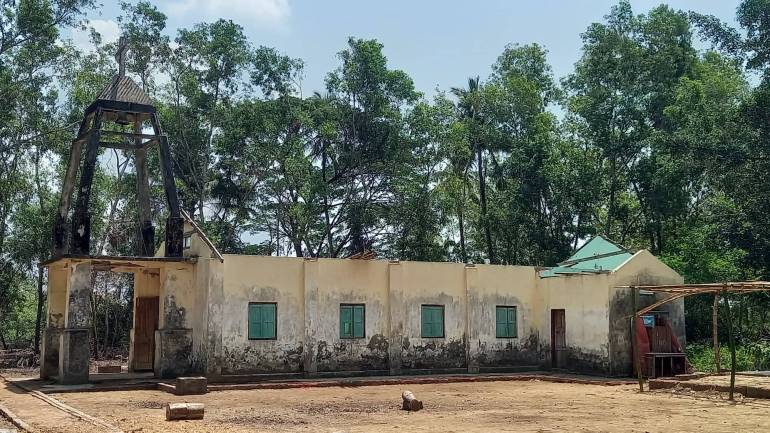Scars left by Nargis Cyclone in Myanmar exist after 14 years

The unforgettable event happened in the first week of May 2, 2008, in Myanmar, especially in Yangon and Ayeyarwaddy Regions known as the delta.
It was the worst natural disaster which was known as Nargis Cyclone.
According to factsanddetails.com, the Nargis caused 138,000 dead and 2.5 million people to be homeless. It has been 14 years.
RVA staff went to the Cyclone affected Island where the parish of Painneigone is located and interviewed the survivors there.
The first question is whether the situation is becoming normal like before Nargis Cyclone.
“The situation is becoming normal compared to the situation immediately after Nargis,” answered Mahn Sein Win.
He added, “But we still have difficulties in living due to the Covid-19 pandemic.”
Another villager who is called Mahn Maung Tin Shwe said in reply, “Before Nargis, everything was alright. We had sufficient instruments for agriculture and fisheries. We had the money for investment and selling and buying.”
Shwe continues that after Nargis, they are still in difficulties living on agriculture due to inadequate financial support and climate change.
“The villagers’ business is currently crabs selling and buying. We cannot completely say that the situation becomes normal like before Nargis,” he said.
U Lin Lin expressed from the viewpoint of a fisherman. Before Nargis, it was not free for them to make crabs to sell and buy because there were arrests by authorities. But after Nargis, it is freer for them to earn by catching crabs and selling them.
According to factsanddetails.com, the Nargis caused 400,000 hectares of farmland to be flooded with seawater in the Yangon and Ayeyarwaddy regions of Myanmar. The farmland flooded by seawater could not cultivate the plants.
U Tin Win commented that the situation is not yet like before Nargis.
“We cannot yet cultivate our gardens which were damaged during the Nargis cyclone. There are many needs to become normal situations like before Cyclone,” explained Win.
Nant Pwar, the 55-year-old mother, said that they could live in their garden and cultivate plants before Nargis.
After Cyclone, they could not cultivate their garden so they had to migrate from Lain Maw Gone village to Painneigone village.
Regarding their survival within 14 years after Nargis, the interviewees unanimously responded that a few months after Nargis they could survive with the support from NGOs/INGOs and Myanmar Church.
When NGOs and INGOs had stopped their support, they could continue to live with self-support until now. But economically speaking, they are mostly poor.
The education of local people before and after Nargis was also questioned.
Before Nargis, many parents could support their children for education because their small or big business was quite good.
A few high school boys and girls are found in the village. Due to poverty, instead of going to school, the teenagers go to gardens or fisheries to help their parents. For this reason, a few teenage students are found in the village.
According to locals, the population of schoolboys and girls before Nargis is more than after Nargis. The number of schoolboys and girls after the Nargis cyclone becomes lesser.
After education, it comes health conditions.
The health situation after Nargis is better than before Nargis.
After Nargis Cyclone, many health caretakers were coming into the villages. Health care after Nargis is better according to locals.
For local people, drinking water becomes a big problem for Cyclone. Before the natural disaster, drinking water was well received in their areas. They had good drinking water under the ground. But after calamity, water under the ground became salty.
No more good water exists in the villages. Currently, villagers are using rainwater stored in the reservoir for a drink.
RVA News asked locals whether they are ready to bear or be resilient to a natural disaster such as the Nargis cyclone if it comes back again.
Many villages such as Painneione, Payar Lay Gone, Takeyokegone, Zee Phyu, and Ngadantayar are not yet ready for disasters. They need shelters.
“We are going to die if a natural disaster such as Nargis Cyclone comes again,” said one of the village elders in Tayokegone Village.
There are over 50 houses in the Tayokegone village.
For villagers, the church which was the building was their refuge when Cyclone hit their village.
Now the roof of the church is damaged. They will not be able to take refuge inside the church anymore if any cyclone hits the village. - With inputs by RVA Pwo Karen
Radio Veritas Asia (RVA), a media platform of the Catholic Church, aims to share Christ. RVA started in 1969 as a continental Catholic radio station to serve Asian countries in their respective local language, thus earning the tag “the Voice of Asian Christianity.” Responding to the emerging context, RVA embraced media platforms to connect with the global Asian audience via its 21 language websites and various social media platforms.











